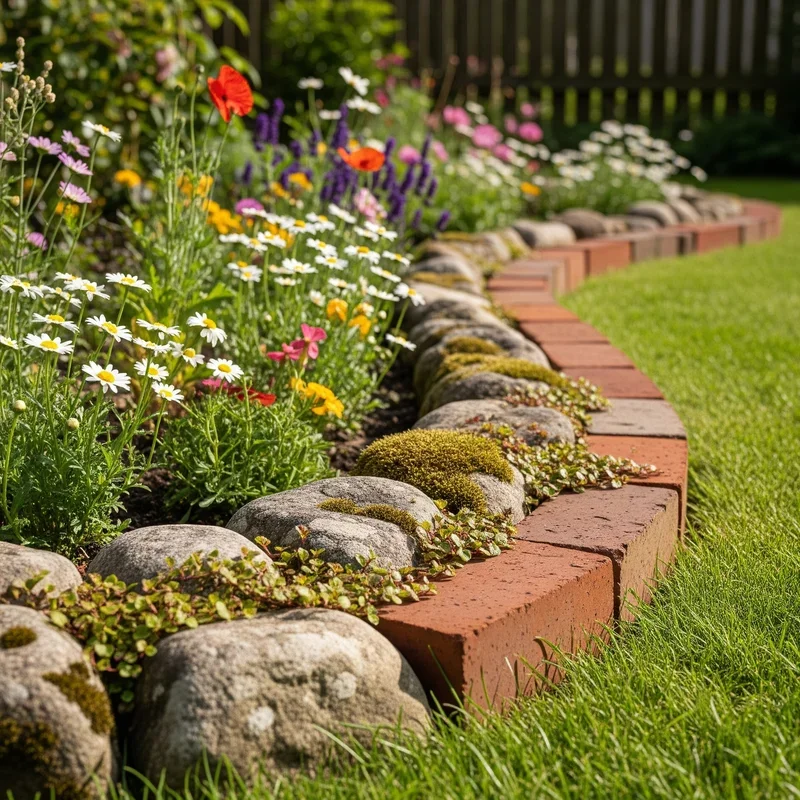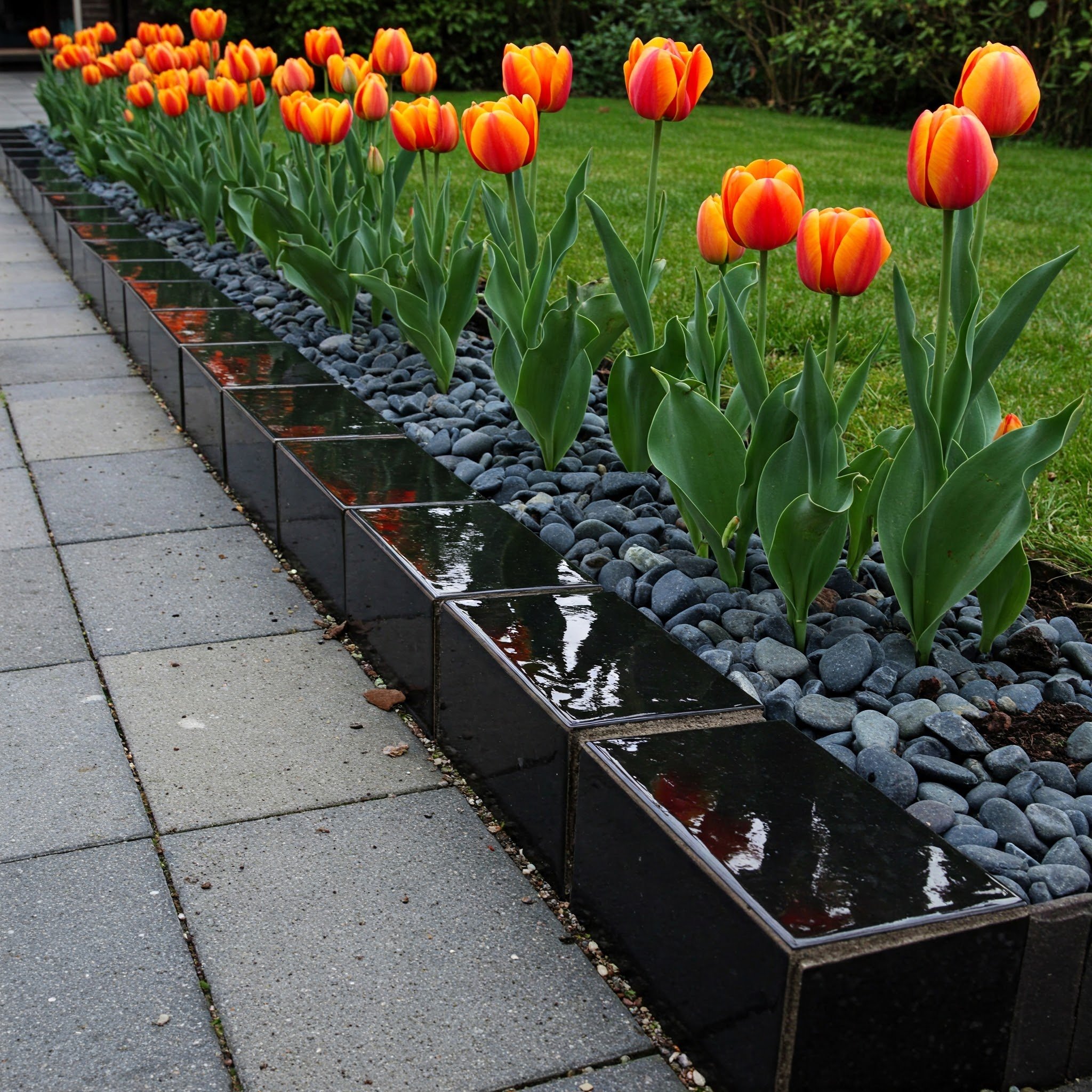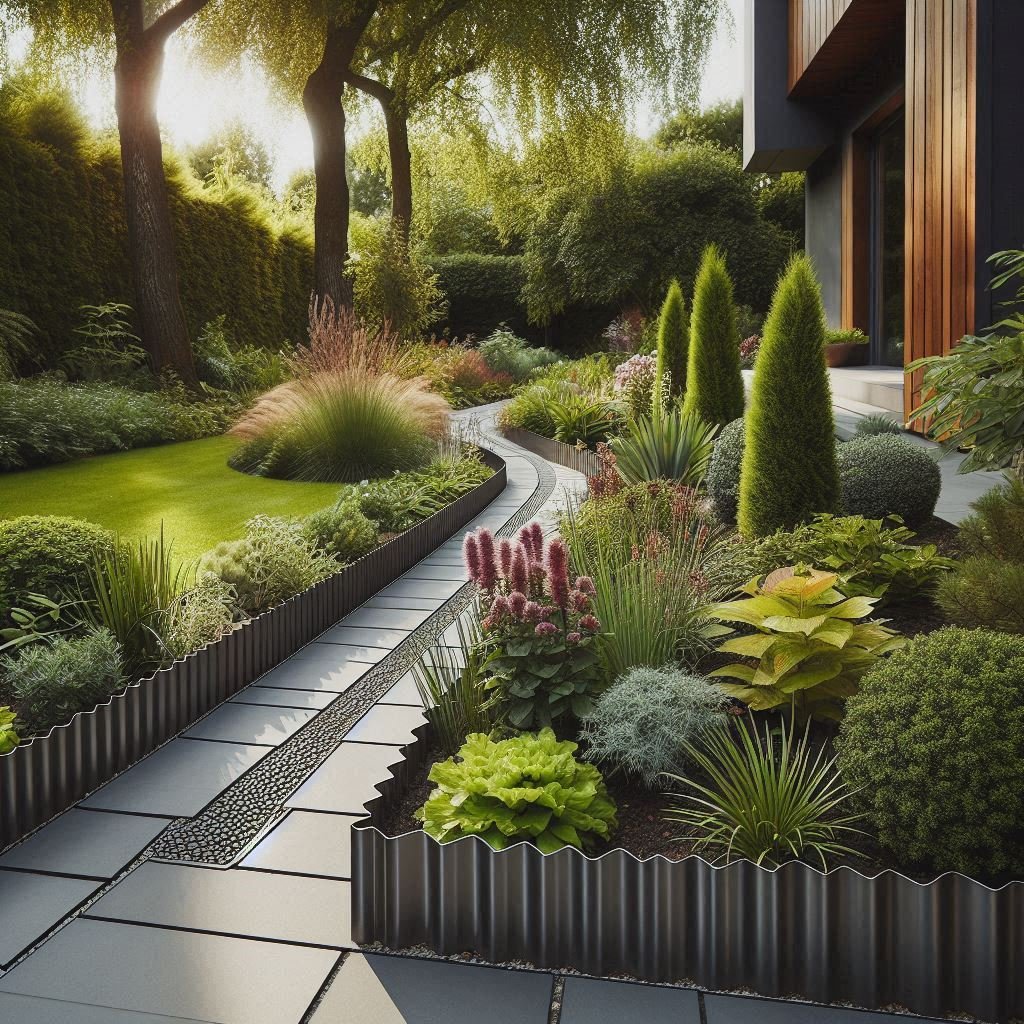15 Rustic Garden Edging Ideas for a Natural Outdoor Look
Transform your garden with these 15 rustic edging ideas using natural materials. From stone borders to woven branches, create stunning outdoor spaces!
Ever notice how a picture frame transforms a painting from nice to stunning? That's exactly what garden edging does for your outdoor space. The right border doesn't just separate your lawn from flower beds; it tells a story, creates rhythm, and turns chaos into harmony. Rustic edging takes this concept further by embracing nature's imperfect perfection, using materials that look like they've always belonged in your landscape. Whether you're channeling cottage garden vibes or creating a woodland wonderland, these natural borders blend seamlessly with plants while adding structure and definition. Forget those plastic strips from the hardware store that scream "artificial" louder than a neon sign. We're diving into authentic materials that weather beautifully, support local ecosystems, and make your garden look like it was designed by Mother Nature herself with just a little help from you.
1. Natural Stone Border Arrangements
Stack flat fieldstones like nature's own puzzle pieces to create borders that look like they've been there since the ice age. These stones don't need mortar; gravity and strategic placement keep them stable while allowing flexibility for future adjustments. Collect stones from your property or source them locally to ensure they match your region's geological character. Vary the heights for visual interest, placing larger stones at curves or corners for stability and impact. The irregular shapes create pockets perfect for tucking in creeping thyme or sedums that soften harsh edges. Over time, lichens and moss colonize the surfaces, adding patina that money can't buy. This edging works brilliantly for cottage gardens, woodland paths, or anywhere you want that "discovered ruins" aesthetic. The thermal mass of stones also creates microclimates, warming soil in spring and protecting roots in winter.
2. Weathered Log Edging Designs
Transform fallen trees or old fence posts into rustic borders that bring woodland charm to any garden space. Lay logs horizontally for traditional edging or stand them vertically at varying heights for a stockade effect that adds dramatic vertical interest. The natural decay process enriches surrounding soil while providing habitat for beneficial insects and fungi that support garden health. Cedar and redwood resist rot naturally, lasting years without treatment, while softer woods decompose faster but cost nothing if sourced from your property. Partially bury horizontal logs to prevent rolling and create stable mowing edges that simplify lawn maintenance. The organic curves of logs complement informal planting styles perfectly, making straight lines impossible and therefore unnecessary. As wood weathers, it develops silver-gray patinas and interesting textures that synthetic materials can never replicate authentically.
3. Woven Willow Branch Borders
Channel ancient garden traditions with wattle fencing techniques that transform pruned branches into living art. Weave flexible willow, hazel, or even grapevines between stakes to create borders that look like they've been lifted from a medieval monastery garden. This technique costs virtually nothing if you have access to suitable branches, turning yard waste into functional beauty. The height is completely customizable; make them low for subtle definition or tall for mini-fence effects that keep rabbits at bay. Fresh willow branches might actually root and sprout, creating living fences that change through seasons. The woven texture provides perfect support for climbing plants like sweet peas or nasturtiums that thread through gaps. Replace sections as needed without dismantling entire borders, making maintenance refreshingly simple. This edging biodegrades naturally, enriching soil as it decomposes over several years.
4. Reclaimed Brick Patterns
Old bricks carry stories in their chips and weathered surfaces, bringing instant history to garden borders. Salvage them from demolition sites, old chimneys, or architectural salvage yards where imperfect bricks sell for fraction of new prices. Stand them on end for sawtooth patterns, lay them flat for broader borders, or angle them for diagonal designs that create visual movement. The warm terracotta tones complement both cool green foliage and hot-colored blooms equally well. Mismatched bricks from different sources add character that uniform new bricks lack, creating borders that look accumulated over generations. The porous nature of old bricks absorbs and releases moisture, helping regulate soil conditions near border edges. Some vintage bricks feature maker's stamps or unique glazes that become conversation starters during garden tours.
5. River Rock Garden Edges
Smooth river rocks create zen-like borders that bring serenity and natural flow to garden designs. These water-worn stones come in various sizes and colors, from tiny pebbles to bowling ball boulders, allowing creative graduated effects. Dig shallow trenches and fill with rocks for permanent borders that never need replacing or maintenance beyond occasional repositioning. The spaces between rocks provide excellent drainage, preventing water from pooling and causing root rot in adjacent plants. Choose local river rock to ensure your edging harmonizes with regional landscapes rather than looking imported or forced. Dark wet-look sealers enhance natural colors if you prefer more dramatic effects, though many gardeners love the subtle, sun-bleached appearance. River rocks also work brilliantly as mulch within borders, creating unified designs that blur lines between edging and garden bed.
6. Split Rail Fence Edging
Miniaturize the classic American frontier fence into garden-scale borders that evoke pioneer homesteads and country roads. Use actual split rails cut shorter or purchase pre-made decorative versions designed specifically for edging applications. The zigzag pattern of traditional split rail creates interesting shadows and provides multiple planting pockets for different conditions. Weather-resistant woods like locust or cedar last decades without treatment, developing beautiful silver patinas that complement any planting scheme. The open structure doesn't block views or airflow while still clearly defining spaces and keeping feet on paths. Stack just two rails high for subtle borders or go three high for more substantial barriers that discourage shortcuts. This edging particularly suits native plant gardens, wildflower meadows, or any landscape celebrating American rural heritage.
7. Driftwood Border Creations
Bring beach vibes inland with driftwood pieces that add sculptural interest while defining garden boundaries naturally. Each piece is unique, weathered by wind and waves into organic shapes that manufactured edging could never replicate. Arrange larger pieces as focal points at corners or entrances, filling between with smaller branches for continuous borders. The silver-gray coloring provides neutral backdrop that makes plant colors pop while never competing for attention. Salt-weathered wood resists decay naturally, though pieces from freshwater sources work equally well with different weathering patterns. Partially bury pieces for stability or wire them to stakes for more temporary arrangements you can adjust seasonally. Combine driftwood with beach grass, lavender, or other coastal plants for authentic seaside garden themes, even hundreds of miles from ocean.
8. Bamboo Garden Boundaries
Sustainable and stylish, bamboo edging brings Asian-inspired tranquility to gardens while growing more popular as gardeners embrace eco-friendly materials. Use whole culms horizontally for bold borders or split bamboo for more delicate effects that suit smaller gardens. The natural variation in node spacing and diameter creates rhythm without monotony, keeping borders interesting along their entire length. Bamboo's hollow structure makes it lightweight for easy installation while remaining surprisingly durable when properly treated or naturally weather-resistant species are chosen. Create different heights by cutting culms at angles or varying placement depths for undulating borders that mirror natural landscapes. The golden tones of dried bamboo warm up shady areas while complementing both tropical and temperate plantings beautifully. Replace individual pieces as needed without disturbing established sections, making long-term maintenance manageable.
9. Recycled Wine Bottle Edges
Turn empty bottles into colorful borders that catch light and create unexpected garden sparkle. Bury bottles neck-down for stable edging that won't tip or roll, creating rows of glass circles that look like giant gems. Green, brown, and clear bottles offer different effects; mix colors for playful borders or stick to one shade for sophisticated monotone designs. The glass creates interesting light patterns throughout the day as sun angles change, adding dynamic element to static borders. This recycling solution costs nothing if you save bottles or ask restaurants for their empties, turning waste into garden art. The thermal mass of glass helps moderate soil temperatures, protecting roots from extreme temperature swings. Consider LED string lights behind translucent bottles for magical nighttime effects that transform gardens into fairyland settings.
10. Moss-Covered Rock Walls
Encourage moss growth on stone borders to create edges that look like they've existed for centuries. Stack stones with gaps for planting pockets, then spray with buttermilk or yogurt mixtures to accelerate moss colonization naturally. The soft green cushions blur harsh edges between hardscape and plants, creating seamless transitions that feel completely organic. North-facing borders develop moss fastest, though shady locations anywhere support these primitive plants that add timeless character. Different moss species create varied textures from velvety smooth to delightfully fuzzy, adding tactile interest to visual appeal. The living border changes subtly through seasons, brightening after rain and adding ethereal beauty when frost-covered. This approach works especially well in woodland gardens or shady areas where traditional edging might look too manufactured or stark.
11. Terracotta Pot Borders
Repurpose broken or surplus terracotta pots into charming borders that celebrate gardening itself as decorative element. Bury pots halfway at angles for scalloped effects, or stack various sizes for dimensional borders with built-in planting pockets. The warm orange tones complement green foliage perfectly while aging beautifully with white mineral deposits and moss growth. Fill visible pots with trailing plants, succulents, or seasonal annuals for borders that double as mini garden beds. Old pots with chips and cracks add character that new pots lack, turning imperfections into rustic charm. The porous clay helps regulate moisture and provides beneficial minerals as it slowly breaks down over many years. This edging particularly suits Mediterranean, cottage, or herb gardens where terracotta's traditional associations enhance overall themes.
12. Gabion Wall Edging
Create modern rustic borders with wire cages filled with stones, combining industrial structure with natural materials perfectly. These modular systems allow incredible flexibility in height, width, and fill materials from river rocks to recycled concrete. The cage structure means no mortar or precise stacking required, making installation faster than traditional stone walls. Fill gabions with different materials in sections for striped effects, or graduate from large to small stones for subtle texture variations. The spaces between stones provide habitat for beneficial insects and small wildlife that support garden ecosystems. Gabions work especially well on slopes where they provide both edging and erosion control simultaneously. The industrial mesh softens over time with rust or vine growth, eventually disappearing behind plants while maintaining structural integrity.
13. Living Hedge Boundaries
Plant low hedges of boxwood, lavender, or ornamental grasses for edging that grows more beautiful each year. These living borders change through seasons, offering flowers, fragrance, and movement that static edging never provides. Choose plants suited to your climate and maintenance preferences; some need regular trimming while others maintain natural shapes independently. The root systems help prevent erosion while improving soil structure along border edges where compaction often occurs. Living edges provide habitat and food for pollinators, birds, and beneficial insects that enhance overall garden health. Start with small plants spaced appropriately for mature size, using temporary edging until hedges establish and fill gaps. This approach costs more initially but pays dividends through years of beauty without replacement needs.
14. Salvaged Metal Edging
Rescue old roofing tin, salvaged steel strips, or weathered copper from scrapyards to create edging with industrial patina. The rust and verdigris add colors that complement both flowers and foliage while telling stories of previous lives. Partially bury metal strips vertically for clean lines that slice through landscapes with surgical precision contrasting organic plant forms. The thin profiles take minimal space while providing excellent root barriers that prevent grass invasion into beds. Metal conducts heat, warming soil in spring for earlier blooming and extended growing seasons near edges. Cut or bend pieces for curves, corners, or height variations that follow landscape contours naturally. Some metals like copper naturally repel slugs and snails, providing pest control bonus alongside decorative function.
15. Pine Cone and Bark Borders
Gather pine cones, bark chunks, and other forest floor materials for borders that smell as good as they look. These lightweight materials work perfectly for temporary or seasonal edging you can change with moods or garden evolution. Large pine cones stood on end create textured borders that catch rain and slowly release moisture to nearby plants. Mix different cone types and sizes for varied textures that prevent monotony along longer borders. The natural browns blend seamlessly with mulch while providing clear definition between lawn and beds. As organic materials, they decompose slowly, enriching soil and supporting mycorrhizal fungi networks that benefit plant health. This free edging solution simply requires collection time and works especially well in woodland or native plant gardens where it enhances naturalistic themes.
Conclusion
Your perfect rustic garden edge exists somewhere among these natural options, waiting to frame your planting beds with authentic character. The beauty of rustic edging lies in its imperfection, its ability to age gracefully, and its harmony with nature. Start with one section, experiment with materials, and let your borders evolve organically. Remember, the best garden edges are the ones that make you smile every time you see them while keeping your maintenance minimal and your garden naturally beautiful.
Read next: 15 Recycled Garden Edging Ideas for a Greener Garden
Frequently Asked Questions
Q1: How deep should I bury rustic edging materials?
A: Bury one-third of the height for stability while maintaining visual impact above ground.
Q2: Which rustic edging lasts longest?
A: Stone and quality hardwood logs endure decades; cedar and redwood resist rot naturally.
Q3: Can I mix different rustic edging styles?
A: Yes, transitioning between materials at corners or features creates dynamic, collected-over-time appearances.
Q4: How do I maintain rustic garden edges?
A: Reset shifted pieces annually, replace degraded organic materials, and trim encroaching plants seasonally.
Q5: What's the most budget-friendly rustic edging?
A: Collected stones, fallen branches, and recycled materials cost nothing but time and effort.






















